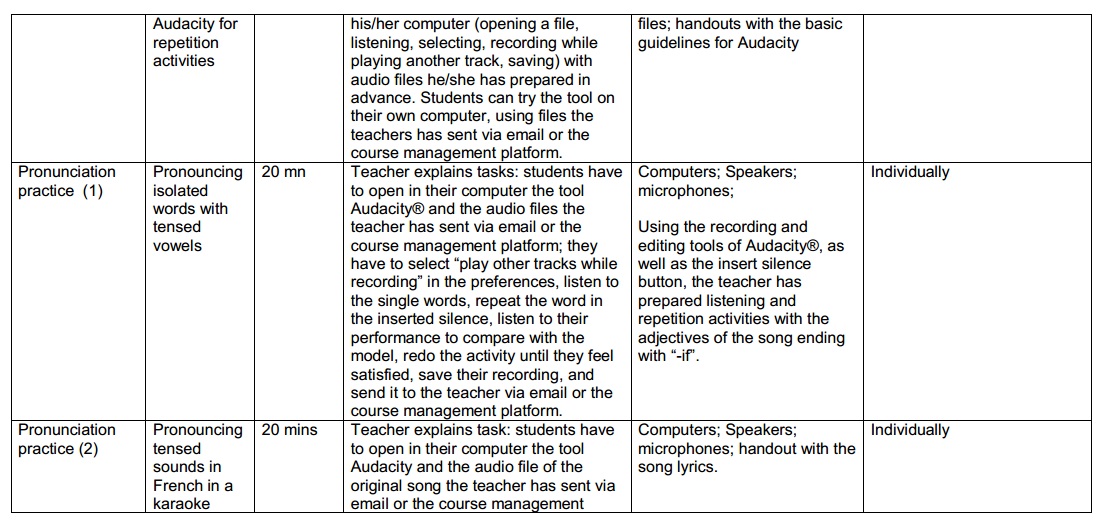“Audacity®” is an effective tool in FLT
Introduction

Main Idea: Change educational priorities to build a better generation
Aim: To give a full vision of Audacity and to show its effectivnes for self - development in FLT
Objective:
- Explain what Audacity and sound files are and why they are useful to teach languages.
- List the kind of tasks that would be appropriate for their students using Audacity.
- Explain how to design tasks focused on student collaboration.
- Give an example of one activity in a lesson plan using Audacity in alignment with the Standards for Foreign Language Learning.
- Describe how to assess students’ learning progress using Audacity.
- Critique the effectiveness for language teaching of other Audacity projects.
- Download “Audacity” and create their own Audacity projects.
- Teach their students how to make their own Audacity projects.
Audacity is a tool for creating and editing audio files (downloading and editing podcasts, recording interviews, creating personal
audio messages, etc.).
Audacity is a free open source digital audio editor and recording computer software application, available for Windows,Mac OS X, Linux and other operating systems. Audacity was started in May 2000 by Dominic Mazzoni and Roger Dannenberg at Carnegie Mellon University. As of 10 October 2011, it was the 11th most popular download fromSourceForge, with 76.5 million downloads. Audacity won the SourceForge 2007 and 2009 Community Choice Award for Best Project for Multimedia.
Audacity's features include:
- Importing and exporting of WAV, AIFF, MP3 (via the LAME encoder, downloaded separately), Ogg Vorbis, and all file formats supported by libsndfile library. Versions 1.3.2 and later support Free Lossless Audio Codec (FLAC). Version 1.3.6 and later also support additional formats such as WMA, AAC, AMR and AC3 via the optional FFmpeg library.
- Recording and playing back sounds
- Editing via cut, copy, and paste, with unlimited levels of undo
- Multitrack mixing
- A large array of digital effects and plug-ins. Additional effects can be written with Nyquist
- Built-in LADSPA plug-in support. VST support available through an optional VST Enabler.
- Amplitude envelope editing
- Noise removal based on sampling the noise to be removed
- Audio spectrum analysis using the Fourier transform algorithm
- Support for multi-channel modes with sampling rates up to 96 kHz with 32 bits per sample
- Precise adjustments to the audio speed (tempo) while maintaining pitch in order to synchronize it with video or run for a predetermined length of time
- Adjusting audio pitch while maintaining speed
- Features of modern multitrack audio software including navigation controls, zoom and single track edit, project pane and XY project navigation, non-destructive and destructive effect processing, audio file manipulation (cut, copy, paste)
- Conversion of cassette tapes or records into digital tracks by automatically splitting the audio source into multiple tracks based on silences in the source material
- Cross-platform operation — Audacity works on Windows, Mac OS X, and Unix-like systems (including Linux and BSD)
- Audacity uses the wxWidgets software library to provide a similar graphical user interface on several different operating systems.
Task
Audacity for language learning and teaching
-Speaking tasks
-Pronunciation practice
-Listening comprehension
This is a pronunciation activity that is appropriate for an intermediate group of high school or university students studying French as a second language. It is based on the song of Etienne Daho “if” (Paroles: Etienne Daho. Musique: Ginger Ale. Duo with Charlotte Gainsbourg. Album "Réévolution", 2003) and can include a listening activity such as the one developed by Carmen Vera Pérez andfreely accessible at the following address: http://platea.pntic.mec.es/~cvera/hotpot/daho.htm This song can be interesting because of the large number of qualifying adjectives to describe one’s personality, but, from apronunciation point of view, because of the repetitive use of adjectives ending in “–if” in a context of tensed articulation. French pronunciation is, indeed, characterized by a tensed articulation of its vowels and consonants, compare to other languages which produce diphthongs or reduced vowels.
Process
Evaluation
|
Fluency
40points
|
Accuracy
30points
|
Cohesion
15points
|
Coherence
15points
|
| Student 1 |
|
|
|
|
| Student 2 |
|
|
|
|
Conclusion
The Audacity sound recorder and editor is a useful free tool that teachers can utilize to create new materials and design learning tasks for their students. Its user-friendly interface makes it equally easy to use for students at all proficiency levels. They will be able to record and personalize podcasts, practice pronunciation, and mediate authentic listening materials to suit their proficiency level. Motivated students can take advantage of the wide array of features the program offers, yet only basic knowledge of control commands is needed to record and convert audio files using this versatile software.
Credits
Teacher Page





